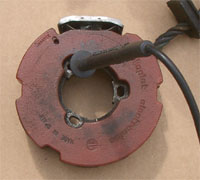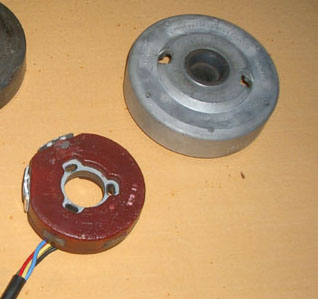Pekka Förbom (Finland), pekka.forbom@postikaista.net
Charges between 100 and 130 euro depending on the work. He has the
machinery to
rewind the coils. He repairs both motoplat and SEM systems.
Vintage Dirt Bike (USA), www.vintagedirtbike.com
All electronic ignition models
$195 complete, 6 month warranty, quick turn around
Phone: (832) 788-5306 FAX: (270) 588-5627
Stator Rewinds (Australia), http://www.dropbears.com/r/rewinds/
All motorcycle stators rewound
to factory specs or better.
Phone: +61 (0)243 692 313
Fax: +61 (0)243 692 313
 There
are basically two types of ignition systems. First the internal flywheel
type. These doesn't have lightning coils and is mostly common on motocross
bikes. The smaller diameter flywheel was supposed to make the engine revier
with quicker response. Consequently the idle and low rev, trail properties
are worse. The external rotor (flywheel) sometimes has lightning coils.
The larger diameter places most of the rotating mass further out and therefore
makes the engine more stable at lower revs. It also build revs slower and
is therefore more suitable in enduro applications. Another negative effect
is that the larger rotating mass adds a gyroscopic effect to the rotating
engine which makes the bike harder to lean down in turns. This is a somewhat
odd physical thing that easiest can be explored with a plain hand grinding
machine
There
are basically two types of ignition systems. First the internal flywheel
type. These doesn't have lightning coils and is mostly common on motocross
bikes. The smaller diameter flywheel was supposed to make the engine revier
with quicker response. Consequently the idle and low rev, trail properties
are worse. The external rotor (flywheel) sometimes has lightning coils.
The larger diameter places most of the rotating mass further out and therefore
makes the engine more stable at lower revs. It also build revs slower and
is therefore more suitable in enduro applications. Another negative effect
is that the larger rotating mass adds a gyroscopic effect to the rotating
engine which makes the bike harder to lean down in turns. This is a somewhat
odd physical thing that easiest can be explored with a plain hand grinding
machine  rotating
in your hands. While it does so, try to flick it sideways and you will
feel what the gyroscopic effect will do. Basically what it's all about
is that once a moving force is applied onto a rotating body the outcoming
movement will be in 90 degrees from the applied forces direction.
rotating
in your hands. While it does so, try to flick it sideways and you will
feel what the gyroscopic effect will do. Basically what it's all about
is that once a moving force is applied onto a rotating body the outcoming
movement will be in 90 degrees from the applied forces direction.
The external rotor comes in a few different types as well. The most
common one has a small pin on the front side that is supposed to fit into
a groove inside the flywheel. It's mounted by three small screws on the
inside near the crank shaft. The outer diameter is about ø83mm.
The inside of the flywheel is ø85mm. The other type is mounted the
same way. Doesn't have a pin on the face but one of the coils has a larger
metal plate surrounding it, it looks like a pickup. The outer diameter
is slightly larger. Just about ø85mm. It will therefore not fit
into the other types flywheel. There is also a smaller type seen on smaller
displacement engines, like the sachs 100-175cc for example. The three mounting
screws is located outside the entire stator plate.
Disconnect both the black and the blue wire from the ignition coil
and kill switch. Connect one test lead to ground and the other to the blue
wire. Interchange the two test leads and read the results. In one direction
there should be infinity and the other there should be a very high resistance.
between 3000 and 9000 ohms. If none of the measurements shows infinity
the diode is defective. This is almost always combined with a significantly
lower resistance, below 100 ohms. If on the other hand one direction shows
infinity but the other a very high reading, well over 10000 ohms the stator
itself is interrupted but the diode is good.
The coil with the red spark plug lead, the one with a diode cannot be tested except for the secondary winding that should be tested exactly as the other one with the black spark plug wire.
What you have to do is to remove the spark plug. Use a gauge to measure the upper deadpoint. Find out how much before the upper deadpoint the spark should occur and then see to it that the flywheel and the stator is aligned the way I described here above. The advance of the ignition is determined of several factors. One is the diameter of the combution chamber. The larger it is the longer time will the burning process take. Another one is the RPM where you would want your engine to perform the best. A third important factor is the quality of the gasoline. An early spark could casue pre-ignition, known as pinging or knock. This is a fatal state for the engine and should, if possible be avoided. Different engines have different specs but here are some guidelines. The lower value is preffered for enduro or other slow pace situations where torque is better. The higher value is better for motocross or desert riding where the engine is going for a higher rev and power output most of the time.
100, 125 & 150cc
2,6-3,1mm before upper deadpoint. These are relatively high values
despite the smaller bore. The reason is that engines this small often revs
higher and due to their power curve they are mostly kept at these revs.
175 to 250cc
1,7-2,5mm before upper deadpoint. The lower RPM combined with the fairly
small bore doesn't require as much pre-ignition.
300-500cc
2,3-2,8mm (3,3-3,8) before upper deadpoint. Here the larger bore will
require a slightly earlier ignition. The reading over 3mm should only be
used on full sized 500cc bikes and in competition. It will stress the piston,
wrist pin and the crank very hard but give the engine all intended horse
power. Another thing is that reading over 3mm greatly increases the risk
of kick-back when starting the engine. This is dangerous and could cause
severe injuries to your foot and leg. We have all heard stories of the
old english bikes and their kick-backs. Forget the entire thing. There
is no engine type intended to be started by foot that kick backs more fiercly
than a full sized 500cc two stroke engine.